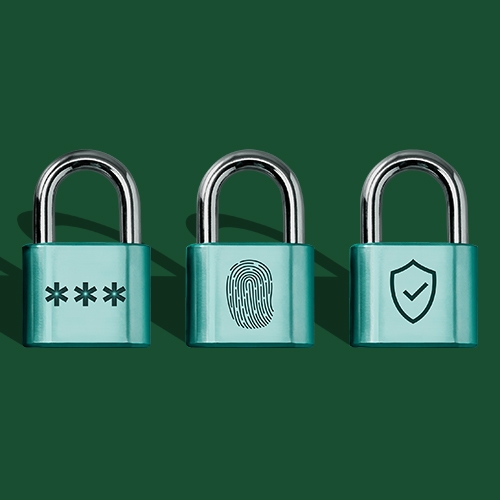Cyber threats, from phishing scams to credential stuffing attacks, get more sophisticated every day. Hackers constantly search for ways to break into systems. In a digital workplace — where sensitive data is stored in the cloud and teams collaborate across borders — relying on passwords alone is no longer enough.
Authentication is a critical safeguard. Even if a password is compromised, secure systems and processes help prevent unauthorized users from accessing accounts or sensitive information. In this article, we’ll explain what multifactor authentication is, why it matters for your business, and best practices.
What is multifactor authentication (MFA)?
Multifactor authentication (MFA) is a security process that requires users to provide two or more independent credentials to confirm their identity before they’re granted access to a password-protected site. Unlike single-factor authentication, which relies solely on a password, MFA introduces additional layers of protection.
For example, when you log into your online banking app, you might enter your password (something you know), then confirm a code sent to your phone (something you have). In workplaces, employees may need to log in with their corporate credentials and then verify with a biometric scan like their fingerprint (something they are).
Multifactor authentication is a standard practice across industries that must protect sensitive data. Examples include healthcare (protecting patient records), finance (safeguarding transactions), government services (securing citizen data), and tech companies (preserving infrastructure and intellectual property). Some of these safeguards include secure file-sharing solutions to help ensure attachments stay in the intended team environment and secure video conferencing to help prevent unauthorized eavesdropping.
How does MFA work?
The strength of MFA comes from requiring multiple, distinct forms of authentication. This minimizes risk because it’s unlikely a hacker would have access to all of these devices or pieces of information. MFA generally falls into three categories:
- Something you know. A password, PIN, or secret question
- Something you have. A physical device such as a smartphone, hardware token, or security key
- Something you are. Biometric identifiers like fingerprints, facial recognition, or iris scans
When a user attempts to sign in to their digital workplace, the system asks for an item from at least two of these categories. Even if one factor is compromised — for example, a leaked password — the others remain a barrier to attackers. This layered approach significantly reduces the risk of unauthorized access.
Why is using MFA important? (And what happens if you don’t)
When users create weak passwords, often reused across multiple platforms, they’re easily exposed through phishing schemes or data breaches. Without multifactor authentication, a stolen or guessed password could open the door for hackers to access corporate systems, financial accounts, or confidential communications.
Four benefits of using MFA
Adopting MFA at the workplace enhances security while reducing intrusions.
- Stronger protection against unauthorized access. If one credential (such as a password) is compromised, additional factors block intruders.
- Reduced risk of phishing and credential theft. Phishing emails or malicious sites may capture a password, but without the second factor in MFA, they often fail.
- Compliance with security regulations. Many regulatory guidelines and security standards mandate or strongly recommend MFA.
- Builds customer and employee trust. Knowing that sensitive data and internal systems are protected by MFA gives peace of mind to staff and external stakeholders alike.
Four risks of not using MFA
Organizations that don’t implement MFA expose themselves to unauthorized access and security issues.
- Higher breach risk. Attackers often exploit weak or reused passwords. Without MFA in place, when credentials get compromised, no further barriers to your systems exist.
- Regulatory noncompliance. Industries such as finance, healthcare, and government require MFA under standards like the Health Insurance Portability and Accountability Act (HIPAA), the Payment Card Industry Data Security Standard (PCI DSS), the National Institute of Standards and Technology (NIST), and others. Failing to comply may lead to fines, legal exposure, and loss of certifications.
- Reputation damage. Data breaches or unauthorized disclosures erode customer and partner trust.
- Financial losses. Costs from breach remediation, incident response, lost business, and potential regulatory penalties can be severe.
MFA methods and examples
After embracing the benefits of using MFA to protect secure data, learn how to put MFA in place with these four approaches.
One-time passcodes (OTPs)
These temporary codes are sent via SMS, email, or an authenticator app (like Google Authenticator or Authy). For example, logging onto a social media platform on a new device, such as a smartphone or laptop, triggers a code sent to your email or via an app to authenticate your identity.
Hardware security keys
Physical devices such as YubiKey or other FIDO2-compliant tokens work with MFA. When logging in, you insert or tap the key to verify your identity. This method is highly resistant to phishing scams.
Biometric authentication
MFA can use fingerprint scans, facial recognition, retina/iris scans, or voice recognition. These are frequently used on mobile devices or laptops to add a seamless extra layer of security.
Adaptive MFA (risk-based authentication)
This method evaluates contextual signals — such as login location, the device being used, time of day, or prior behaviors — to decide whether additional authentication is needed. For example, logging in to a work platform from a laptop in a different country might trigger a second factor even if you normally only use one.
Many organizations use more than one of these methods. For instance, a secure office building might use biometric verification for regular access and hardware keys or app-based OTPs for high-risk situations or top-level administrative access.
Adaptive MFA and AI in authentication
Let’s dig into that last method a bit deeper. Adaptive authentication represents a more dynamic, intelligent approach to multifactor authentication. Rather than applying the same level of authentication every time, adaptive MFA assesses risk based on the context of each potential entry. These include:
- Geographic anomalies. Adaptive MFA engages when logging in from unfamiliar regions.
- Device or network changes. When a user logs in from a new device or an unknown Wi-Fi connection, adaptive MFA activates.
- Behavioral patterns. Launch adaptive MFA when users log in at unusual times of day or multiple times within the hour.
AI (artificial intelligence) and machine learning further enhance adaptive MFA by learning user behavior over time, enabling more accurate detection of suspicious activity while minimizing friction. For example, an AI system (aka digital labor) might recognize that an employee typically logs in from Berlin in the mornings; if there’s a login from Tokyo at 2 a.m., it may trigger extra verification steps.
This approach ensures stronger security when needed and convenience when risk is low, improving both protection and user experience. After all, no employee wants to get locked out of a work system while traveling simply because their behaviors and usual login attempts have shifted to new times. Completing the security measures asked of an adaptive MFA system gives workers access when needed.
MFA best practices
Organizations can implement these ideas when adopting or strengthening MFA policies:
- Standardize MFA policies across all teams, apps, and devices so there are no weak links.
- Educate employees on secure use of MFA, including how to recognize phishing attempts and what authentication tactics the company uses.
- Offer minimal user friction without sacrificing security. For example, consider using authenticator apps or biometrics rather than always relying on SMS.
- Enforce MFA, especially for privileged accounts and administrators, such as those with elevated access or control over critical infrastructure.
- Integrate MFA into collaboration tools and work operating systems such as Slack.
- Audit and update policies regularly to account for evolving threats, new compliance requirements, or better technologies such as stronger biometrics or new hardware keys.
How Slack supports secure authentication
Slack is built for modern, distributed teams under the guiding principle that security is foundational — not optional. Slack’s approach to securing user access and data includes strong MFA support by integrating with identity provider apps and workplace security practices.
By using Slack’s MFA support and integrating with its secure infrastructure, businesses protect sensitive conversations, workflows, and shared resources without sacrificing usability.
Seamless integration with leading identity providers (IdPs)
Slack supports single sign-on (SSO) apps that enforce MFA, giving organizations greater control and consistency. For example, users can secure their Slack accounts using authenticator apps or hardware security tokens, reducing reliance on weaker authentication methods, such as SMS. Also, Slack’s Enterprise Key Management (EKM) encryption keys feature includes enhanced MFA options.
Data privacy and security
Slack provides transparency about how it protects user data through encryption, rigorous security processes, and compliance. This ensures Slack data, such as conversations, files, and integrations, are protected. Secure tools also must support secure processes. The Slack Enterprise Grid enforces enterprise security and guards against unauthorized access by giving admins more control over user and device permissions.
MFA in today’s business world
As cyber threats become more complex, multifactor authentication is a must-have security practice in modern business operations. By layering in additional identity checks — using biometric data, hardware tokens, or adaptive AI-driven verification — organizations can dramatically reduce risk, meet compliance obligations, and build trust among employees and customers alike. Implementing MFA isn’t just an enhancement; it’s essential resilience in a digital, distributed world.






